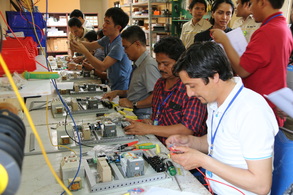
The Hydro Empowerment Network (HPNET), co-founded by Dipti Vaghela (left) in 2012, brings practitioners a knowledge exchange platform to advance micro-hydro power. HPNET focuses primarily on “policy, technology, and socio-environmental aspects for sustainability.” Vaghela, who serves as HPNet’s coordinator, talks to Microgrid News & Insight in this first of a two-part interview. In part 1, Vaghela talks about the benefits of micro-hydro and the connection between local communities and project successes.
MGN: Micro-hydro power is more complex and time-intensive to set up than solar PV. Why is it worth that investment?
DV: Economically, micro-hydro is more cost-effective than solar PV [when the hydro resource is adequate and nearby -Ed.]. Studies and programs across the board list hydro power as the most cost-effective renewable energy technology. Dependent on perennial streams, micro-hydro does not require the recurring costs of battery storage [often] involved in solar PV. Micro-hydro can cost-effectively provide more kWs and AC power, leading to greater productive use of electricity — a crucial requirement to financially sustain mini-grids and increase their poverty-alleviation impact. [Editor’s note: Hydro power may also involve batteries, depending on the resource.]
Unlike solar, the sustainability of micro-hydro is directly linked to…local watersheds. This means that to sustain the micro-hydro resource, the local watersheds must be strong enough to produce enough flow of water to power the micro-hydro system. However, the benefits of [protecting] watersheds go far beyond access to electricity. [Sustainable] watersheds lead to climate change mitigation and increased climate resiliency — crucial to indigenous and rural populations, who are most vulnerable to negative impacts of climate change.

HPNET members provide workshops to strengthen the skills of local technicians, who are the first resource communities approach to resolve any technical failure.
MGN: How does micro-hydro power impact local communities?
DV: Micro-hydro technology can be locally procured, locally fabricated, and locally repaired. These abilities result in the creation of a local ecosystem of rural energy service providers and suppliers who make their livelihood by providing clean electricity to un-electrified communities. In addition to stimulating the local economy, this helps to sustain the projects long-term. In most cases, the projects are located too far away to entice external service providers to remain committed long-term. But empowered local actors — trained in installing, operating, and servicing — are in close enough physical proximity, so local beneficiaries are directly involved, and local service providers see an increased vested interest in a project. This involvement actually becomes a mechanism to overcome the complexity disadvantage of micro-hydro to solar.
Solar PV, however, almost always requires imported components that cannot be serviced locally and hence must be replaced upon failure. Often rural beneficiaries of solar PV have no way of contacting the supplier nor funds to replace the imported components, resulting in solar PV skeletons scattered across rural communities.
However, where there is no micro hydro potential or specialized skill sets, solar PV is the go-to technology for various funding agencies providing electricity to off-grid communities. While solar PV is justifiably used as a means of “pre-electrification,” a temporary solution to the central grid, policymakers tend to incorrectly clump mini-grids into this category. Depending on the scale and approach to sustainability, mini-grids such as micro-hydro, biomass gasifiers, and small-scale wind can provide quality and quantity of power that is on par with — and in some cases more reliable than — the electricity provided by the central grid.

Community micro-hydro in Indonesia
MGN: What does community involvement look like?
DV: Healthy local involvement of the community — the type that will ensure long-life of the project — would in effect look like self-transformation of the community. At the starting phase, the community would learn to discover its strengths and weaknesses for the installation period. As the installation reaches completion, the community starts to focus on a governing process to ensure tariff collection and smooth technical operation of the system. They assign paid operators to run the system, who are usually youth from the village who are technically trained. They often develop some form of a village electrification consumers society (VECS) to help structure the governing processes. However, local involvement should ideally go beyond the community. The most successful projects have involved the efforts of local technical service providers, local suppliers, and local government.
MGN: What are some community benefits of micro-hydro over household systems on one end and large hydro projects on the other?
DV: While there are household-scale systems, most micro-hydro systems are village-scale mini-grids that require the participation of all or enough households in the community. The watersheds and water powering the micro hydro are usually shared natural resources that involve the entire community in decision-making. The best micro hydro-developers invest much time and thought into carefully facilitating the community to develop decision-making process most appropriate for their community. This process to build the community’s ability to understand micro hydro and to govern the project so that it lives long beyond commissioning starts many weeks before the technical implementation.
In fact, the primary reason that micro-hydro and mini-grids fail is typically due to community management and watershed issues. Technical issues occur but there is a finite way to address them. Community issues, however, differ from community to community. However, once the community has developed a self-governing structure, over the long-term the structure not only sustains the micro-hydro but is often used by the community to thrive in other areas of its development, such as uniting to stop a large hydro project that encroaches on community land.
MGN: If local involvement is of utmost importance, in what ways do these projects require outside help, what kind of help, and from whom?
DV: As with any rural development intervention, resource persons with specific skill sets are needed to build local capacity. Micro-hydro requires hydrology, civil engineering, mechanical engineering, electrical engineering, and electronics skills to technically implement. Equally important are facilitators who can help to trigger the self-transformation process of the community, so that the community successfully implements the projects and thereby can self-manage the project after its commissioning.
When it comes to scaling a handful of projects into a scaled program that helps to meet national electrification needs, capacity building is also required for policymakers and the government. The process of building local capacity in the local private sector (such as service providers and suppliers) and the local and national government also requires that the resource persons have some prior experience in developing scaled micro-hydro programs.
(Continued in Part 2: HPNET’s projects and future plans)
Dipti Vaghela focuses on decentralized renewable energy solutions in south and southeast Asia. Since 2006, her parallel roles as researcher, practitioner, and facilitator has helped to synergize communities, local entrepreneurs, field-based NGOs, policymakers, and funding agencies in implementing bottom-up, learning process approaches to community-based energy initiatives in rural south and southeast Asia. Dipti is a 2016 recipient of the Fulbright – Clinton Public Policy Fellowship to serve in Myanmar.
